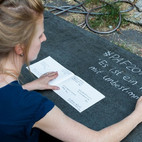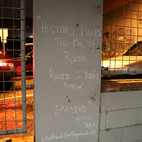

Scribe is designed as a live writing project within festival and event contexts in which artist Scribes capture the experience of members of the public to create the democratic document of the festival.
It seeks to put into question hierarchies of power and enable diverse voices and experiences to be the document for artists, public and future researchers to engage with as a fuller and more layered resonant outcome of the live event.
It was commissioned in 2016 by Arts House Melbourne for the Festival of Live Art and has since been re-commissioned by Spill Festival, UK, Dance Massive, Australia’s national program of dance in 2017+ 2019, the Keir Choreographic Awards Melbourne, Performing Arts Festival Berlin, Tanz Im August Berlin, Melbourne Writers Festival and in 2019 will return to Berlin for Performing Arts Berlin and present for the first time in India.
Leisa Shelton, SCRIBE, SPILL Festival of Performance 2016, produced by Pacitti Company.
Video by Ana Godinho de Matos for Chameleoneye Films.
FULL PROJECT EXPERIENCE
Public scribes and private encounters
By Theron Schmidt
Contemporary Performance Review / April 2016.
SCRIBE, led by Australian artist and curator Leisa Shelton, collects anonymous experiences from public contributors.
The collections take place not by audio-recording, but in a
face-to-face, time-delimited session with a designated ‘scribe’ who listens, converses, and records the experience in writing.
The writing session is framed by carefully aestheticised details: the session takes place over a customized, hand-crafted, portable writing desk; the contributor is anonymized and his or her designated number is recorded inside a bureaucratic stamp; and the scribe is identified by some kind of self-nominated archetype — e.g. The Maker, The Academic, The Researcher, The Drawer,
The Evaluator, The Writer, The Cynic.

SCRIBE AT FESTIVAL OF LIVE ART,
MELBOURNE, 2016.
PHOTO ALEX TALAMO

In this way, the act of transcription is foregrounded as also a transformation: not the transparent capture of thoughts and experiences, but a transaction, a service, an act of labour that is shaped by the properties of the room and the roles being played.
Conversing, listening, writing, testifying… even where the technology is analogue, not digital, this is a mediated encounter in which the media being used is crucial (and visible) in shaping what is voiced and what is written down.
SCRIBE DESKS AT FESTIVAL OF LIVE ART, MELBOURNE, 2016. PHOTO- ALEX TALAMO.

SCRIBE AT FESTIVAL OF LIVE ART, MELBOURNE, 2016. PHOTO- SARAH WALKER.
The other distinguishing feature is that Scribe is situated within the context of an art festival—in its first iteration, at Melbourne’s Artshouse as part of the city-wide Festival of Live Art. So, at first glance, it seems to function similarly to an audience-feedback or evaluation framework, in that the subject matter at-hand is the other artistic work on display. But unlike the forms that these evaluations typically take, there are not pre-determined questions or criteria; and the experience is held by the attendant scribe, opening a space for wandering associations and reflections that may include details of the respondent’s personal life, thoughts about the building or the part of town, and other curiosities that might arise.
In this way, it collects what might be described as an ‘affective archive’, to borrow the concept from the Performance Studies International Regional Cluster organized in 2010 by Marco Pustianaz, Giulia Palladini, and Annalisa Sacchi, in which, as those organizers would later reflect, ‘What gets remembered will mostly be unmemorable.’

SCRIBE AT FESTIVAL OF LIVE ART,
MELBOURNE, 2016.
PHOTO ALEX TALAMO
In the Melbourne iteration of Scribe, I was invited to observe and participate as writer-in-residence. One of the conditions of participation (for both contributor and scribe) is that the anonymous texts are freely available for re-use and circulation, and in my discussion with the Scribe artists we became interested in extending these private exchanges into public space: selecting short excerpts and chalking them onto walls and pavements, making visible both the content and also the act of writing itself. In this way, the walls and sidewalks became animated with anonymous voices, identified only by number, speaking back to the events contained within them. There were also other acts of translation: into Braille, and through the production of limited-edition handmade books. As my final gesture as writer-in-residence, I sifted through the collected documents (now carefully stored in archival boxes), selecting and collating fragments of experience to form this polyvocal accumulation:
I am writing this because I volunteered myself. I am writing this because it felt important to me that these words be written down. Because it felt important to me that some words were written down. Because these may not be all the words but because these are the words that I was able to write down in the time and space that was designated.
I am writing this because I have a friend who’s in town for the weekend (#044). Because there was a lot going on in the moment. Because it wasn’t entirely easy to focus on the artwork itself (#026). Because it’s impossible to re-create the internal feeling that caused that moment in me that was captured (#005). Because you asked me what I thought and this is what I was able to say. Because sometimes I get lost in the lighting (#056). Because you can smell green when you walk in (#015). Because the world was so large (#003). Because of that sense of shocked tingling of dizziness (#028). Because it felt like a rope punctuated by knots I could hold (#012). Because these words are now the knots of what is left over, and as I pass the rope, the knots move between my hands and yours. Because this is the kind of experience I want (#008).
I am writing this because the experience is never mine alone. Because I kept having flashbacks to something, like you have to learn how to approach people(#031). Because I’m not good at speaking with strangers. Because I tend not to join in but rather listen (#053). Because you asked me to, and I accepted, and somewhere in-between it became less clear whether this was my idea or yours. Because my question is, what is the object that is created? Because if the work is a democratic gesture, what does your vote mean? (#001) Because I can just say a thought and then it will become words; it’s like magic (#015). Because
it’s almost
like a
conversation
but without being face to face (#038).
I am writing this because I feel strongly about this. Because I’ve been left with an overwhelming experience of women being better at making live art than men (#004). Because I felt really beautiful in that space and I haven’t been feeling that way for a while (#032). Because I’ve kind of quit art (#037). Because I couldn’t help but see super-imposed histories placed upon images that happen in the present (#048). Because I don’t know if that is quintessentially Australian (#056). Because I was wondering whether the girls in the audience were looking at his penis. Because I was (#061). Because I feel the weight of my
H I S T O R Y (#039).
I am writing this because I wanted to be included (#043). Because I wanted to mix my thoughts with yours. Because I wanted to be up-close (#043). Because I wanted to be intimate (#043). Because I wanted you to carry away a little piece of me. Because I wanted to be able to see the dance (#043). Because I wanted to touch your skin.
I am writing this because I wanted to leave an inscription.
This is an edited extract of an article published in the on-line version of Contemporary Performance Review. To see the full article go to –
http://www.contemporarytheatrereview.org/2016/vox-populi/
For more information on Scribe – contact Leisa Shelton – fragment31@gmail.com
PUBLIC READING
In September 2017, as part of OPEN House Melbourne, Dance House presented the first Australian public reading of Scribe. Across a full afternoon, public documents from Scribe presentations at Dance Massive 2017, were made available to visitors of Dance House to read, discuss and enter into shared dialogue on, with Scribe – Olivia Satchell.
Across the program, lead artist Leisa Shelton performed a durational ‘Live Writing’ of extracts from these Scribe documents which moved from the pavement leading to the front door of Dance House, through out the building, up the stairs and to the final exit point at the back door of the House. Live writings and Public readings are part of the continuance of the Scribe project and will be held in several host venues across 2018.
To view the full set of live writing videos from SCRIBE at Dance Massive
Festival of Live Art/ Arts house, Melbourne AUS 2016








SPILL Festival of Performance 2016/ Ipswich UK








Dance Massive / Melbourne AUS 2017




Keir Awards KCA 2018/ Dancehouse 2018




Performing Arts Festival/ Berlin 2018








Tamz IM August /Berlin 2018








Dance Massive / Melbourne AUS 2019








Heritage weekend/ Ballarat AUS 2019





PRODUCTION /RE-COMMISSIONING REQUIREMENTS
Scribe is led by Leisa Shelton, with LOCAL artists gathered in each city / context it is commissioned for. For this, Leisa requires to be in the city at least one week prior to commencement to meet and prepare the Scribes and select sites and Strategies for undertaking the project within each unique context.
There are 5 hand made desks, which are fully portable and transportable for national and international engagement, with a purpose build travel case.
Packed they weigh 12kg as a single unit and travel as booked luggage with Leisa.
Scribes work within a series of formic languages – written, drawn, brailed, mapped etc, and the project can be undertaken in any given language with the single requirement of a translator (if not English or French) for Leisa Shelton to facilitate the project and the public outcomes.
The project can be sited indoor and outdoor, within private and public spaces and requires no other materials except those supplied by the project.
A full public ARCHIVE of the documents will be given and so held by each commissioning festival / event with the requirement that they be Archived in such a way as to be accessible to members of the public, artists and interested others for reading / research or as part of public conversations and future engagements.
The artist keeps all original documents for future ARCHIVING of the full project.
MEDIA
The listening in of Scribe, temporarily etched into the pavements and sites of Ipswich, a dispersed democratic record (testimony as poetics).
November 2016 | Diana Damian-Martin | SPILL Writer in Residence
Fragment 31’s Scribe blurs performance and documentation to catch and release the experiences of members of the public; if you are keen to explore your experience in a liminal space between, yet within the festival, highly recommended.
March 2nd 2016 | Marty Shlansky | TheMusic.com.au
My favorite encounter of the night was Scribe – a project that seeks to democratically document the festival by initiating one-on-one conversations with a theatregoer and a scribe (a writer or drawer on the night I was there – I chose the drawer) who listens to your account of the night and documents your experience, which will be added to hundreds of other documents in order to encapsulate the mountain of experiences of the festival.
March 10 2016 | Laura Elizabeth | TheatrePeople.com.au
Scribe from Fragment 31 was a good way to round the evening out. The eponymous scribe interviewed participants about what they thought of these passing experiences, and the interviews are to be compiled into a public record. Articulation, the debriefing, became another performance, but one that would become a permanent trace of all the other performances.
March 10 2016 | Owen Richardson | The AGE
CREDITS
Concept: Leisa Shelton
Writer in Resident: Theron Schmidt
Project Assistant: Alex Talamo
You might also be interested in:
ADDENDUM
MAPPING

